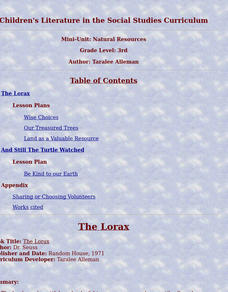Curated OER
The Consequences of Our Consumer Behavior - Toys And Games
Students examine how consumer information can protect consumers from unsafe products. They identify popular games and toys, discuss labelling, role-play sharing and playing safely with toys, and plan and design their own safety...
Curated OER
Watershed Model
Students view a presentation of water and land and how we need to protect our water resources. In this water lesson plan, students discuss how we rely on water, and complete activities in all subjects related to water.
Curated OER
Management of Commercial Fisheries, Part 2
Students examine the differences between the past vs. the present fishing and the uses of fisheries. In this investigative lesson students complete a worksheet and learn to think critically in order to protect our environment.
Curated OER
Creepy Crawlies
Second graders study the world of insects. They join Greenpatch Kids, an organization of young people who are interested in nature and want to protect our environment. In addition, the students assess use of technology as a valuable...
Curated OER
Our Environment
Pupils engage in a literature study that helps students to connect with some of the issues of conservation. They list parts of the environment that need protection with the help of a graphic organizer. Then pupils discuss in groups why...
Curated OER
Earth: Our Big Blue Marble
Students investigate Earth and its resources. For this Earth, space, and nature lesson plan, students collaborate to design presentations on the Earth, its cycles, and how humans have impacted the planet. Images, diagrams, and background...
National Wildlife Federation
Quantifying Land Changes Over Time in Areas of Deforestation and Urbanization
Is qualitative or quantitative research more convincing when it comes to climate change? In the eighth instructional activity during this 21-part series, scholars begin by performing a quantitative analysis of deforestation and...
Curated OER
Water Resources and the Role of the Independent Sector
Students identify the need to maintain and protect our natural resources. In this natural resource lesson, students study pictures of the effects of pollution on animals and water. Students brainstorm a list of ways water is an...
Curated OER
Watershed Protection
Students explore environmental care by participating in an Earth science activity. In this clean water activity, students discuss what a watershed is, how they become polluted, and how it affects the overall quality of drinking water....
Curated OER
Toxic River
Learners explore environmental safety by participating in a class game. In this toxic chemicals lesson plan, students discuss the effect chemicals have on our environment and how to best protect against their dangers. Learners...
Curated OER
Land as a Valuable Resource
Young scholars investigate why the soil is important to our lives. For this natural resources lesson, students have a farmer as a guest speaker. Young scholars begin to understand how farmers use and protect our natural resource....
Curated OER
What Is a Watershed?
Middle schoolers explore the concept of water pollution. In this environmental stewardship instructional activity, students discover what watersheds are and consider how to protect them.
Curated OER
Where Do All the Toxins Go?
Students demonstrate how chemicals accumulate in fish fat. They study path ways of toxins in the fish's body and ways to prepare fish to avoid consuming the toxins. They examine U.S. and Canada regulations to protect the environment.
Curated OER
Text for Dictation: The Environment
In this dictation text worksheet, students take dictation from a selection using vocabulary concerning the environment.
Curated OER
Interactions Everywhere!
Students examine interactions within the environment and environmental engineering careers. They discuss and view photos of natural and manmade environments, explore various websites, create a web to identify interactions between living...
Curated OER
Relationships, Rules, and Responsibilities
First graders identify jobs in the environment. For this social justice lesson, 1st graders describe rules to protect the environment and the roles specific jobs play. Students construct environmental rules for an imaginary town.
Curated OER
Animal Electronic I.D.
Students discover ways to keep the animals in our environment safe by examining electronic I.D. tags. For this animal safety lesson, students participate in a role-playing activity in which they are monitored by an electronic I.D....
Curated OER
Moebius Strips
Students make Moebius strips and use them to demonstrate the interconnectedness of an environment. They explore the natural cycles (water, oxygen/carbon dioxide, carbon, nitrogen) within the environment. They describe how the cycles are...
Curated OER
Earth Day
Students access a variety of Earth Day themed websites. They locate ideas to celebrate the holiday and examine how to protect the environment and conserve energy.
Salt River Project
How Do We Clean Polluted Water?
How do we clean up oil spills and other pollutants in the water? Explore water treatment strategies with a set of environmental science experiments. Groups remove oil from water, work with wastewater treatment, and perform a water...
Alabama Learning Exchange
Good Litter, Bad Litter
Which ones can be thrown on the ground? Discover the difference between natural litter and unhealthy trash, helping scholars by using several examples. Use the information here to give them a basic background, but also encourage prior...
Curated OER
Polluting the Environment
Fourth graders construct mini-ecosystem, pollute the ecosystem, observe, collect, and record data on the effects of these pollutants on their ecosystem, organize data on spreadsheets, create graphs, and design presentations to share with...
Curated OER
Oil Spill Dangers
Students analyze the effects of oil spills on our environment and develop action plans to protect animals and habitats.
Curated OER
You Can Change the World
Students discuss ways they can help protect the environment. In groups, they examine various types of animals and identify their characteristics, food and habitats are compared. They create a Hyperstudio presentation in which they scan...























